Snakes are often portrayed as aggressive, but almost all snakes retreat at the sight of humans. They’ll only attack if they’re cornered or surprised. However, if this attack comes from the one venomous snake on our list of 8 black snakes in Texas, you’re in trouble.
While snakes seem scary, they play a valuable role in local ecosystems. They keep rodent populations down, which in turn keeps the rates of certain diseases in check. That’s because rodents are known vectors for certain diseases in humans, and snakes are vital in the natural eradication of these pests.
Regardless, that doesn’t mean that all snakes are harmless and all bites will be avoided. As such, it’s best to know what kind of snakes you’ll encounter in the wild in Texas.
Since the deadly cottonmouth is making our list of 8 black snakes in Texas, it’s important to remember the defining characteristics of its non-venomous neighbors so you aren’t unwittingly killing snakes that are good for the environment.
8 Black Snakes in Texas
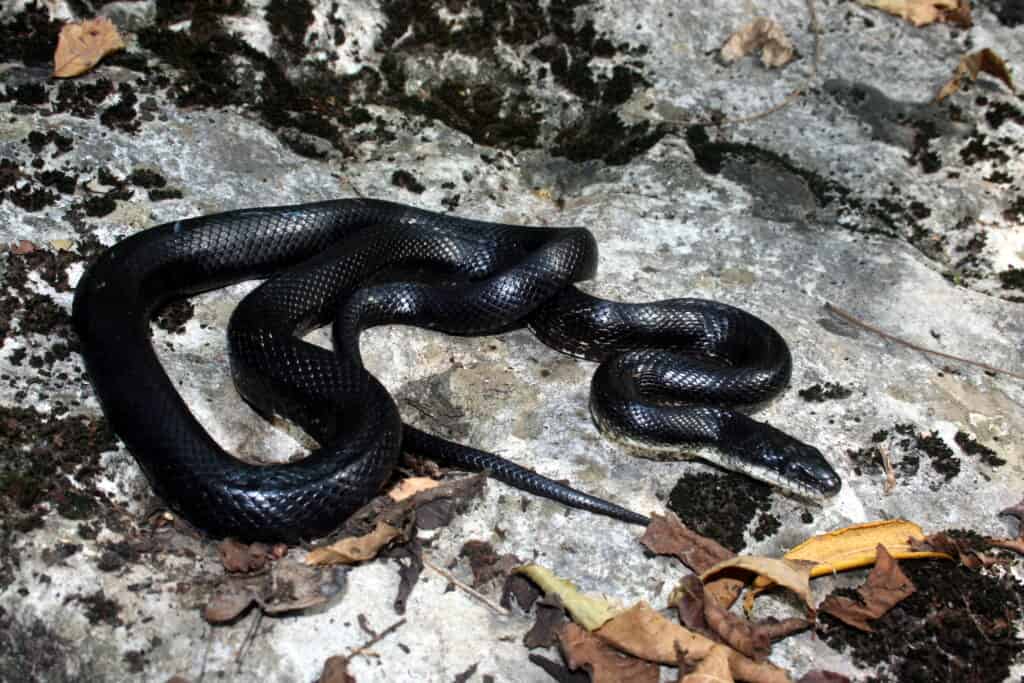
The black rat snake is a type of snake found in Texas.
©Psychotic Nature/Shutterstock.com
These are 8 of the black snakes in Texas:
- Western Cottonmouth
- Gulf Swamp Snake
- Mississippi Green Water Snake
- Plain-Bellied Water Snake
- Broad-Banded Water Snake
- Graham’s Crayfish Snake
- Florida Redbelly Snake
- Texas Indigo Snake
1. Western Cottonmouth
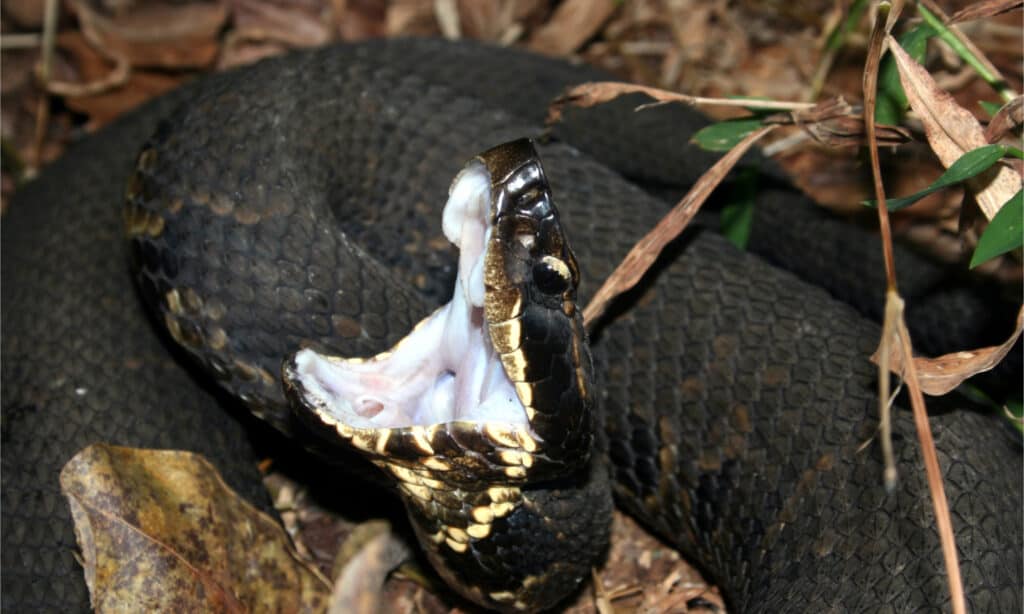
Western cottonmouths are among the venomous snakes in Texas.
©Psychotic Nature/Shutterstock.com
Western cottonmouths are highly venomous pit vipers. They’re also called water mocassins because they are semi-aquatic. They especially like slow-moving water waves, like that found in lakes.
Their mouths, which they bare open when threatened, are as white as cotton, which is how they earned their most common name. They are thick snakes that are generally 2 to 4 feet in length, though the longest ever recorded was over 6 feet long.
Males have a larger home range than females, though both stick close to water no matter where they travel. Western cottonmouths like to chow down on fish, other snakes, frogs, small mammals, and birds.
Their heads are triangular and sometimes adorned with identifiable bands of color. More often than not, these snakes appear all black.
This is the most important snake on our list of 8 black snakes in Texas since it’s venomous, and most of the other snakes on our list are mistaken for this species.
That isn’t to say that they’re famous for biting people. Less than 1% of snake bites annually are attributed to cottonmouths.
2. Gulf Swamp Snake
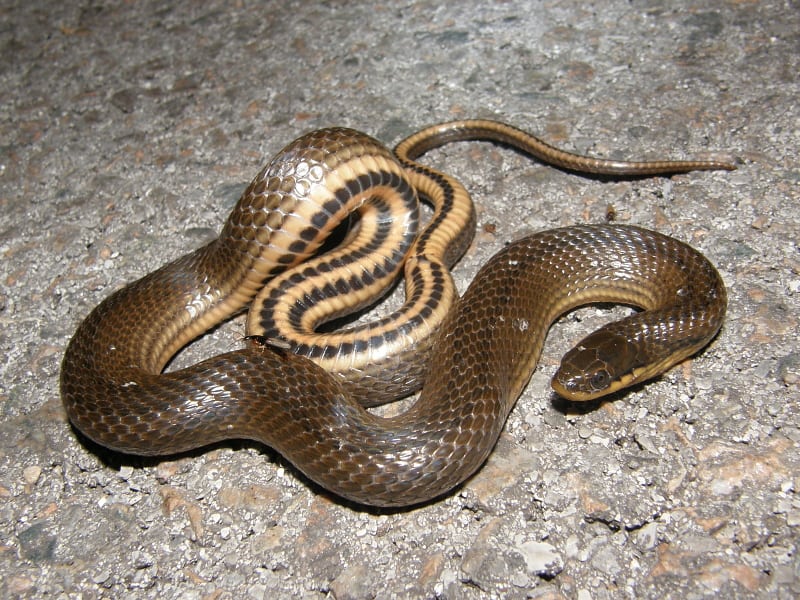
The gulf swamp snake primarily feeds on crayfish.
©John Sullivan / CC BY-SA 3.0 – License
Also known as gulf crayfish snakes, gulf swamp snakes primarily eat crayfish. They do so by eating their victims alive, with the heads going in last. They coil around the crayfish, chomp on its abdomen a few times to immobilize it, then orient it, so the tail can be swallowed first. This is so that the legs of the crayfish will pull forward for easier consumption.
These snakes are found in the lowlands of eastern Texas.
3. Mississippi Green Water Snake
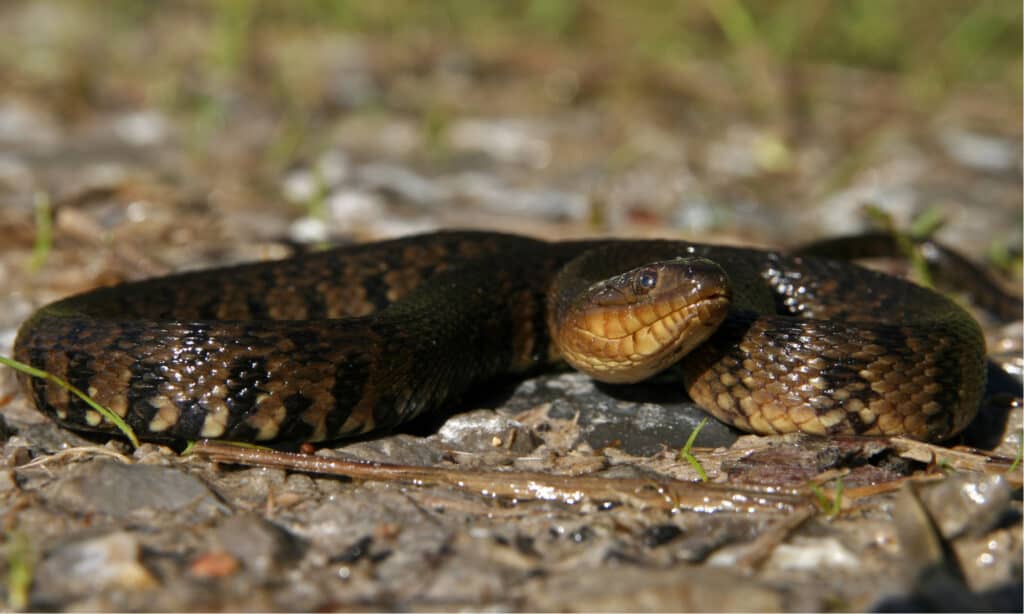
Mississippi green water snakes often appear black from afar.
©Ryan M. Bolton/Shutterstock.com
Mississippi green water snakes grow up to 4.5 feet in length, and they’re generally dark or olive green in color. They often appear black, which is why they made it onto our list of 8 black snakes in Texas.
These snakes are like slow-moving water. Swamps, streams, ponds, and lakes are perfect for them. They aren’t venomous, but they will strike if threatened.
4. Plain-Bellied Water Snake

While plain-bellied water snakes live in the same habitats as cottonmouths, they are distinctly different snakes. They get their moniker from their plain orange bellies. They’re fond of salamanders, fish, and frogs.
Plain-bellied water snakes grow to a bit over 3 feet long. They’re thick-bodied, and their colors vary. One of their more common colors is black, which makes them black snakes in Texas.
These snakes highly prefer permanent water sources like rivers, streams, swamps, and ponds. Cottonmouths will make a meal of these snakes.
5. Broad-Banded Water Snake
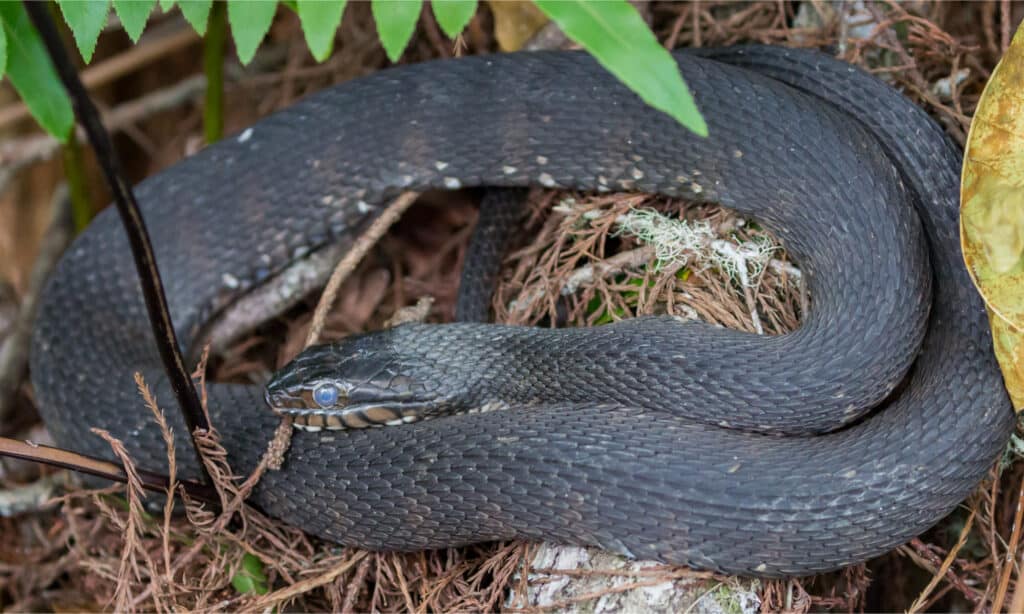
Southern/Banded Water Snake
©EdwinWilke/Shutterstock.com
Broad-banded water snakes hang out near the water, as their name implies. They like to chow down on the same foods as other water snakes, including insects, salamanders, crayfish, fish, toads, frogs, mice, and mammals.
Their vision is terrible, so they prefer to be active in the dark of the night. These snakes are aggressive if cornered, but they’re non-venomous. These water snakes will repeatedly bite if you try to handle them.
6. Graham’s Crayfish Snake
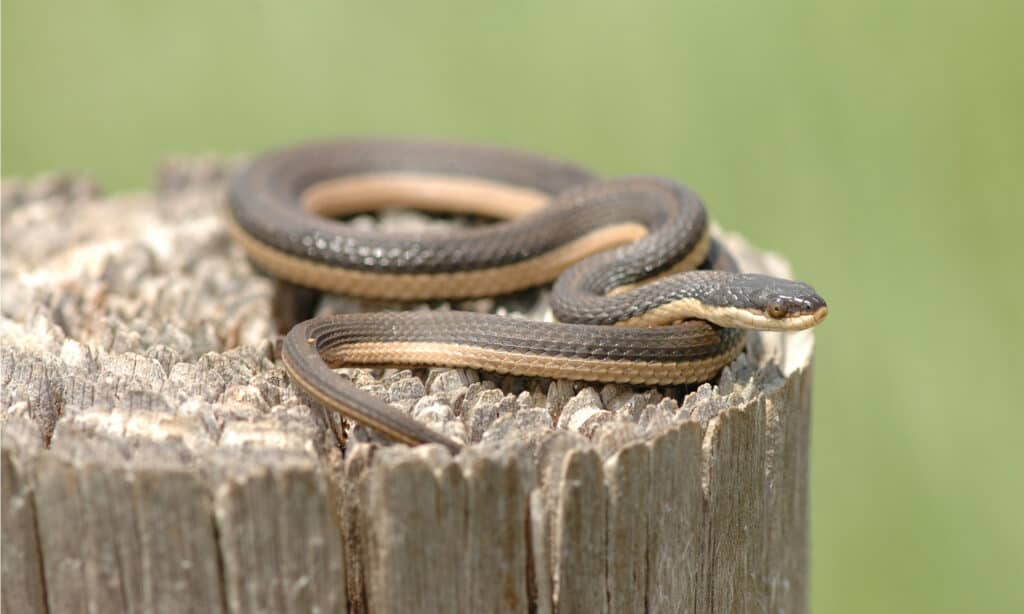
Graham’s crayfish snakes are commonly seen around ponds and other slow-moving bodies of water.
©Rusty Dodson/Shutterstock.com
Similar to gulf swamp snakes, Graham’s crayfish snakes also eat crayfish. They’re dull brown to black. Due to their dull black color, they are considered one of the 8 black snakes in Texas.
Since they like crayfish, they hang out where the crayfish hang out. They like slow streams, lakes, and brackish ponds.
7. Florida Redbelly Snake
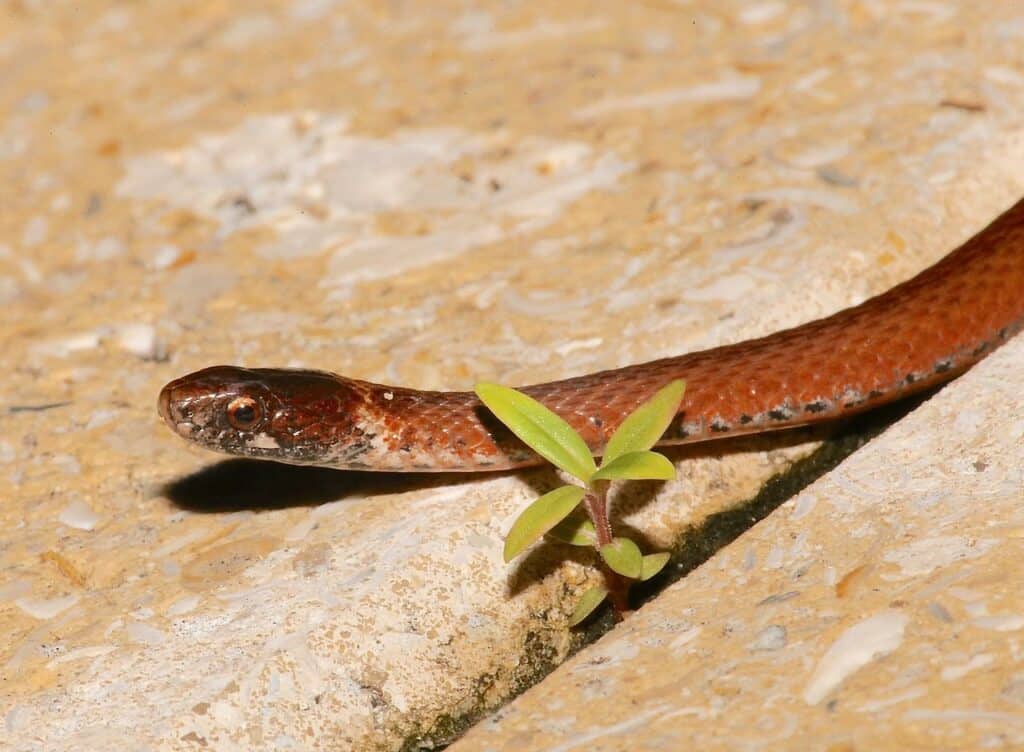
Even though their name says “Florida,” Florida redbelly snakes live in Texas.
©Laura Gaudette / CC BY 4.0 – License
Florida redbelly snakes are little snakes coming in at under 10 inches long. Their bodies are thin, and their bellies are bright red.
Ponds and swamps are their jam. They’re nocturnal, and they like to eat earthworms and slugs.
Generally, these snakes aren’t black, but enough individuals have reported them black that the Florida redbelly snake deserves to be mentioned. Young snakes are darker than adults.
8. Texas Indigo Snake
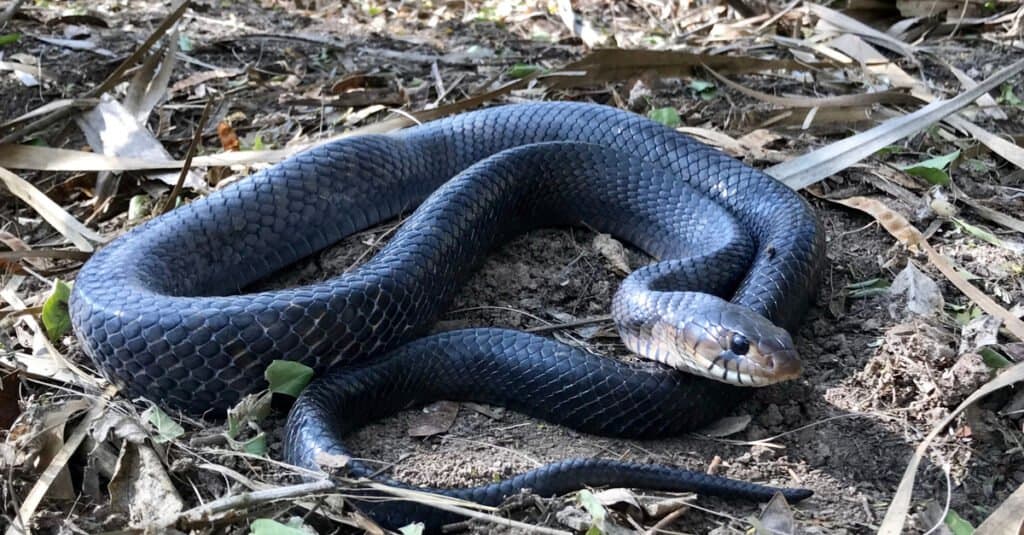
Texas indigo snakes are very long snakes with a base color of iridescent black scales and brown speckles.
©Joe Farah/Shutterstock.com
Ten snake species are protected in Texas, including Texas indigo snakes. These snakes are technically dark blue, but they look so dark sometimes that they appear black.
They grow to an average of 6 feet long, and they’re able to eat rattlesnakes. They can take on rattlesnakes because they’re partially immune to their venom.
Texas indigo snakes’ food is taken down by force, and they’ll eat anything that they can capture. You’ll see them out hunting during the day, though sometimes they burrow under old logs and hang out there.
They’re found in central and south Texas. They also have an iridescence to them, and they’re speckled with brown. The rest of their body is black, except for a pinkish stomach.
Texas indigo snakes are a popular pet choice, as they’re not aggressive. When they bite, though, it hurts.
Other Reptiles Found in Texas
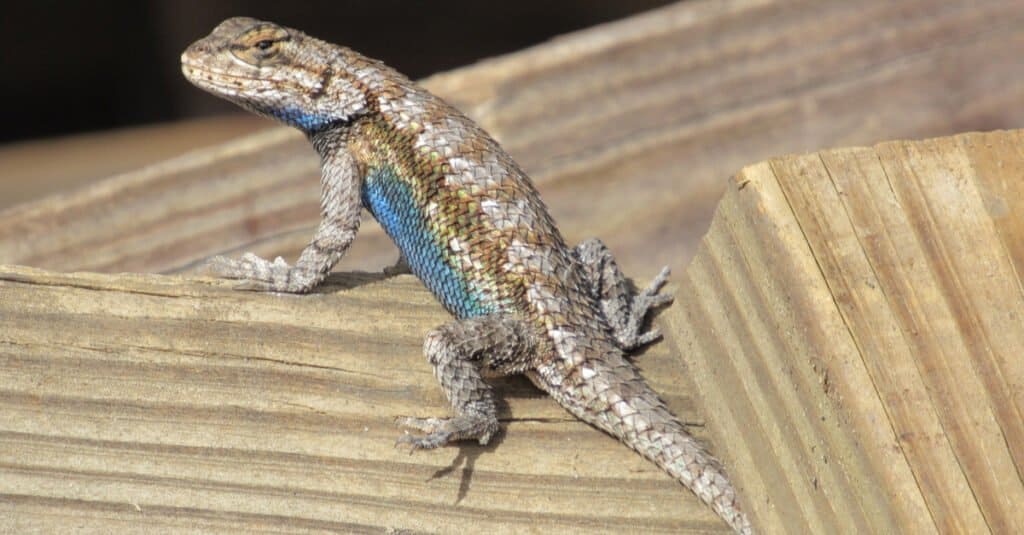
Texas is home to a few different species of spiny lizards.
©Isabel Eve/Shutterstock.com
Texas is home to a diverse range of reptile species, with many of them exhibiting fascinating characteristics and behaviors. From the iconic Texas horned lizard to the elusive western diamondback rattlesnake, these reptiles play important roles in the state’s ecosystems and provide valuable opportunities for scientific research and education.
With that said, here is a short list of other reptiles found in Texas:
- Texas spiny lizard
- Spiny lizards
- Texas horned lizard
- Common Five-lined skink
- Skink
- Green anole
- Eastern collared lizard
- Brown anole
- Roundtail horned lizard
What State Has the Most Snake Attacks?
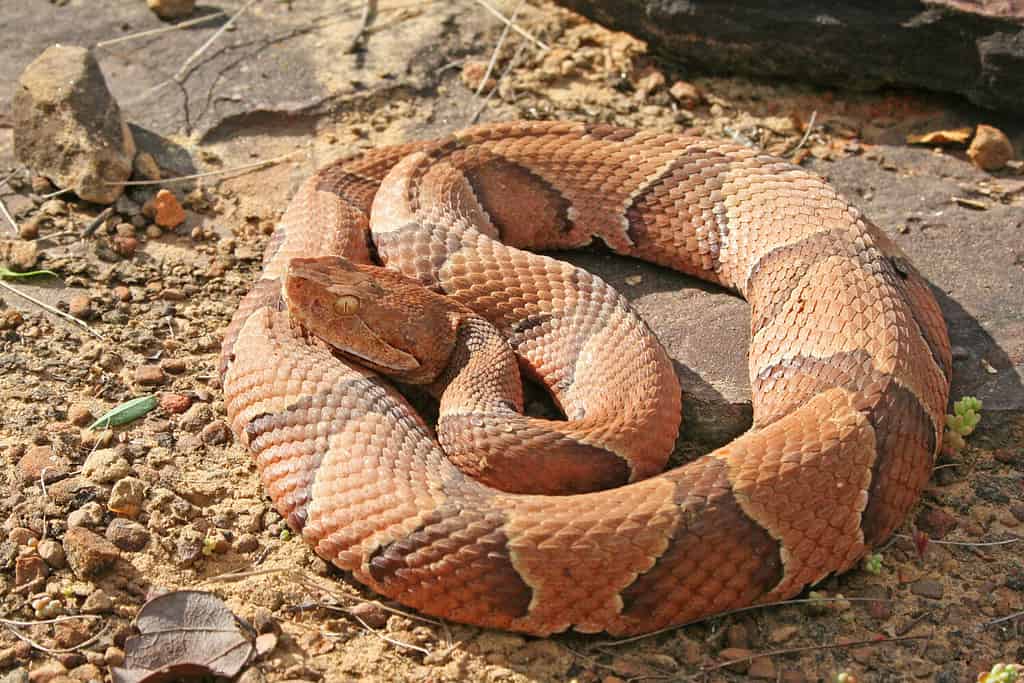
The venomous copperhead snake is among the snakes responsible for snake bites in North Carolina.
©Creeping Things/Shutterstock.com
In Texas, which ranks 6th for the most snake bites per U.S. state, there are an estimated 44.2 bites per million population reported per year. But what state ranks the highest in snake bites? That would be North Carolina. This southeastern state’s bite rate is 157.8 bites per million population per year. How does that average out? Well, the population as of 2021 was a little over 10 million (10.55 to be exact). If we were to just figure it off of 10 million, that would mean that there are roughly 1,580 reported snake bites per year.
The top 6 states for reported snake bites are as follows:
- North Carolina–157.8 bites per million
- West Virginia–105.3 bites per million
- Arkansas–92.9 bites per million
- Oklahoma–61 bites per million
- Virginia–48.7 bites per million
- Texas–44.2 bites per million
In North Carolina, there are 6 different kinds of venomous snakes: copperhead, cottonmouth, timber rattlesnake, pigmy rattlesnake, eastern diamondback rattlesnake, and eastern coral snake. In 2019, 92 people were bitten by venomous snakes in that state.
The photo featured at the top of this post is © Joe Farah/Shutterstock.com
Discover the "Monster" Snake 5X Bigger than an Anaconda
Every day A-Z Animals sends out some of the most incredible facts in the world from our free newsletter. Want to discover the 10 most beautiful snakes in the world, a "snake island" where you're never more than 3 feet from danger, or a "monster" snake 5X larger than an anaconda? Then sign up right now and you'll start receiving our daily newsletter absolutely free.
Thank you for reading! Have some feedback for us? Contact the AZ Animals editorial team.






